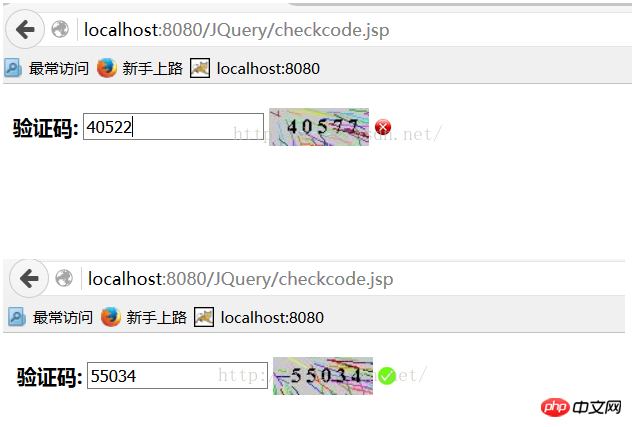
This time I will show you how Ajax+Struts2 implements the user input verification code verification function. What are the precautions for Ajax+Struts2 to implement the user input verification code verification function. , the following is a practical case, let’s take a look.
As we all know, verification codes are very common in our lives. Many companies are tossing out various verification codes. Here is a brief case to implement the function of verification codes ( ps: I actually hate the verification code thing). What I’m sharing today is to use ajax to dynamically verify whether the verification code input is correct. What we use here is ajax+struts2 for this verification. Let's create a new web project. Then you need to import the corresponding package of struts. Then we need to write a class to generate the verification code. The name here is 01_image.jsp. The main function of this type is to generate a verification code, which contains various drawn lines, random numbers, etc. I set up a 5-digit verification here. If you want to change It can be changed into other formats. The general idea is to add letters to the loop that generates numbers.<%@ page language="java" pageEncoding="UTF-8"%>
<%@ page contentType="image/jpeg" import="java.awt.*,java.awt.image.*,java.util.*,javax.imageio.*" %>
<%!
public Color getColor(){
Random random = new Random();
int r = random.nextInt(256);//0-255
int g = random.nextInt(256);
int b = random.nextInt(256);
return new Color(r,g,b);
}
public String getNum(){
String str = "";
Random random = new Random();
for(int i=0;i<5;i++){
str += random.nextInt(10);//0-9
}
return str;
}
%>
<%
response.setHeader("pragma", "no-cache");
response.setHeader("cache-control", "no-cache");
response.setDateHeader("expires", 0);
BufferedImage image = new BufferedImage(80,30,BufferedImage.TYPE_INT_RGB);
Graphics g = image.getGraphics();
g.setColor(new Color(200,200,200));
g.fillRect(0,0,80,30);
for (int i = 0; i < 50; i++) {
Random random = new Random();
int x = random.nextInt(80);
int y = random.nextInt(30);
int xl = random.nextInt(x+10);
int yl = random.nextInt(y+10);
g.setColor(getColor());
g.drawLine(x, y, x + xl, y + yl);
}
g.setFont(new Font("serif", Font.BOLD,16));
g.setColor(Color.BLACK);
String checkNum = getNum();//"2525"
StringBuffer sb = new StringBuffer();
for(int i=0;i<checkNum.length();i++){
sb.append(checkNum.charAt(i)+" ");//"2 5 2 5"
}
g.drawString(sb.toString(),15,20);
session.setAttribute("CHECKNUM",checkNum);//2525
//通过字节输出流输出
ImageIO.write(image,"jpeg",response.getOutputStream());
out.clear();
out = pageContext.pushBody();
%><th>验证码:</th> <td><input type="text" name="checkcode" id="checkcodeID" maxlength="5" /></td> <td><img src="01_image.jsp" id="imgID" /></td> <td id="resID"></td> </tr> </table> </form>
//创建AJAX异步对象,即XMLHttpRequest
function createAJAX(){
var ajax = null;
try{
ajax = new ActiveXObject("microsoft.xmlhttp");
}catch(e1){
try{
ajax = new XMLHttpRequest();
}catch(e2){
alert("你的浏览器不支持ajax,请更换浏览器");
}
}
return ajax;
}//去掉两边的空格
function trim(str){
str=str.replace(/^\s*/,"");//从左侧开始,把空格去掉
str=str.replace(/\s*$/,""); //从右侧开始,把K歌都去掉
return str;
}
document.getElementById("checkcodeID").onkeyup=function(){
var checkcode=this.value;
checkcode=trim(checkcode);
if(checkcode.length==5){
var ajax=createAJAX();
var method="POST";
var url = "${pageContext.request.contextPath}/checkRequest?time="+new Date().getTime();
ajax.open(method,url);
//设置ajax请求头为post,它会将请求的汉字自动进行utf-8的编码
ajax.setRequestHeader("content-type","application/x-www-form-urlencoded");
var content="checkcode="+checkcode;
ajax.send(content);
ajax.onreadystatechange=function(){
if(ajax.readyState==4){
if(ajax.status==200){
var tip=ajax.responseText;
var img=document.createElement("img");
img.src=tip;
img.style.width="14px";
img.style.height="14px";
var td=document.getElementById("resID");
td.innerHTML="";
td.appendChild(img);
}
}
}
}else{
var td=document.getElementById("resID");
td.innerHTML="";
}
}package cn.tf.checkcode;
import java.io.IOException;
import java.io.PrintWriter;
import javax.servlet.http.HttpServletResponse;
import org.apache.struts2.ServletActionContext;
import com.opensymphony.xwork2.ActionContext;
import com.opensymphony.xwork2.ActionSupport;
//验证码检查
public class CheckcodeAction extends ActionSupport{
private String checkcode;
public void setCheckcode(String checkcode) {
this.checkcode = checkcode;
}
/**
* 验证
* @throws IOException
*/
public String check() throws IOException {
//图片路径
String tip="images/a.jpg";
//从服务器获取session中的验证码
String checkcodeServer=(String) ActionContext.getContext().getSession().get("CHECKNUM");
if(checkcode.equals(checkcodeServer)){
tip="images/b.jpg";
}
//以IO流的方式将tip变量输出到ajax异步对象中
HttpServletResponse response=ServletActionContext.getResponse();
response.setContentType("text/html;charset=UTF-8");
PrintWriter pw=response.getWriter();
pw.write(tip);
pw.flush();
pw.close();
return null;
}
}<struts> <package name="myPackage" extends="struts-default" namespace="/"> <action name="checkRequest" class="cn.tf.checkcode.CheckcodeAction" method="check"> </action> </package> </struts>

The above is the detailed content of How Ajax+Struts2 implements user input verification code verification function. For more information, please follow other related articles on the PHP Chinese website!




